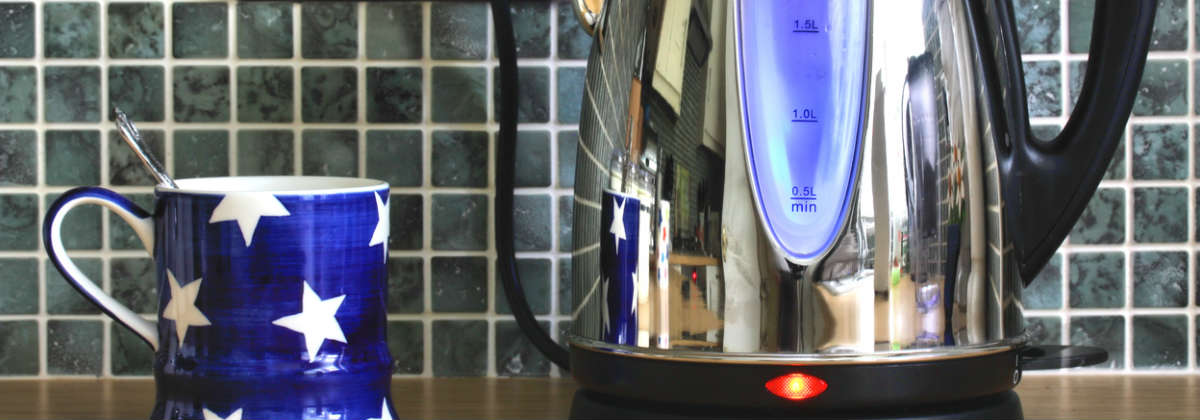KEY POINTS
- A kettle could use between 72W and 147W per cycle, but the actual amount of electricity your kettle uses will depend on its wattage and size.
- An electric kettle tends to cost between five and six cents to boil.
- Boiling your kettle twice per day will add around $30 – $40 to your annual electricity costs.
On this page:
How many watts does a kettle use to boil?
Kettle wattage, which refers to how much energy it will consume within one hour, typically varies between 2000 watt (W) and 2400W, with most commercial kettles ranging in size from 1.5L to 1.8L.
So a 2200W kettle, for example, will consume 2200 watts in one hour. Because boiling water with a kettle takes a mere two to four minutes, a 2200W kettle could use somewhere between 72W to 147W per cycle.
The factors that influence how much power your kettle consumes are not limited to:
- Size: Larger capacity kettles generally consume more energy to boil a larger volume of water.
- Energy efficiency: Kettles with a higher Energy Star rating label will generally enjoy lower average power consumption.
- Usage efficiency: Brewing multiple mugs of homemade coffee could be costing you. The more you use your kettle, the more energy it guzzles. \
- Temperature settings: If your kettle has a temperature control, setting it to a higher temperature will consume more electricity.
Kettle-boiling costs explained
In the table below, Canstar Blue has calculated the cost of boiling a kettle.
Kettle boiling costs based on wattage and size
Based on the findings below, using a 2400W kettle to boil water generally costs between 5.3c and 6.4c per cycle.
| 1.5L | 1.6L | 1.7L | 1.8L | |
|---|---|---|---|---|
| 2400W | 5.4c | 5.8c | 6.1c | 6.5c |
Source: www.canstarblue.com.au – 11/08/2025. Based on the time needed for a full kettle to boil and energy usage for the boiling duration. Time to boil calculated based on: 23°C starting water temp, 100°C ending water temp, and 80% efficiency. Electricity usage cost estimates based on the average electricity usage rate of 32.2 c/kWh for single-rate, non-solar only plans on Canstar’s database, available for an annual usage of 4,373kWh with the exception of Perth which is based on the Synergy Home Plan (A1) tariff and Darwin which is based on the government regulated rate.
You might begin to notice that it’s not the power consumption level that increases the cost of boiling a kettle, but rather its size.
That’s because a more powerful kettle will boil water faster, so while it consumes more electricity at any one moment, this is negated by the kettle’s reduced operating time.
This could be something to keep in mind next time you are in the market for a new kettle, especially if you are looking to reduce some of your household running costs.
Compare energy plans below
Managing your kettle usage is an excellent way to reduce your energy bill spending, but that doesn’t matter if you’re still paying too much for electricity. If your existing plan has high usage and supply charges, you could be left hanging with bill shock. See if you are missing out on a cheaper deal below.
Here are some of the cheapest published deals from the retailers on our database that include a link to the retailer’s website for further details. These are products from referral partners†. These costs are based on the Ausgrid network in Sydney but prices may vary depending on your circumstances. This comparison assumes general energy usage of 3900kWh/year for a residential customer on a single rate tariff. Please use our comparison tool for a specific comparison in your area. Our database may not cover all deals in your area. As always, check all details of any plan directly with the retailer before making a purchase decision.
Here are some of the cheapest published deals from the retailers on our database that include a link to the retailer’s website for further details. These are products from referral partners†. These costs are based on the Citipower network in Melbourne but prices may vary depending on your circumstances. This comparison assumes general energy usage of 4000kWh/year for a residential customer on a single rate tariff. Please use our comparison tool for a specific comparison in your area. Our database may not cover all deals in your area. As always, check all details of any plan directly with the retailer before making a purchase decision.
Here are some of the cheapest published deals from the retailers on our database that include a link to the retailer’s website for further details. These are products from referral partners†. These costs are based on the Energex network in Brisbane but prices may vary depending on your circumstances. This comparison assumes general energy usage of 4600kWh/year for a residential customer on a single rate tariff. Please use our comparison tool for a specific comparison in your area. Our database may not cover all deals in your area. As always, check all details of any plan directly with the retailer before making a purchase decision.
Here are some of the cheapest published deals from the retailers on our database that include a link to the retailer’s website for further details. These are products from referral partners†. These costs are based on the SA Power network in Adelaide but prices may vary depending on your circumstances. This comparison assumes general energy usage of 4000kWh/year for a residential customer on a single rate tariff. Please use our comparison tool for a specific comparison in your area. Our database may not cover all deals in your area. As always, check all details of any plan directly with the retailer before making a purchase decision.
How much is boiling my kettle costing me each year?
According to Canstar Blue’s calculations, making your morning or afternoon cuppa could be costing you as little as $19.35 or as much as $233.60 each year, depending on the number of times you top up your cup in a day and the size of your kettle.
While operating an electric kettle typically only costs between 5 and 6 cents in one sitting, the yearly costs could begin to add up pretty quickly if you are using the appliance multiple times a day.
In the table below, we’ve looked a little closer at these potential costs, using the same assumptions as the table above. These have broken down by boiling the kettle one, two, three, four, five or 10 times a day in a year.
Annual cost of boiling the kettle
| 1/day | 2/day | 3/day | 4/day | 5/day | 10/day | |
|---|---|---|---|---|---|---|
| 1.5L | $19.71 | $39.42 | $59.13 | $78.84 | $98.55 | $197.10 |
| 1.6L | $21.17 | $42.34 | $63.51 | $84.68 | $105.85 | $211.70 |
| 1.7L | $22.27 | $44.53 | $66.80 | $89.06 | $111.33 | $222.65 |
| 1.8L | $23.73 | $47.45 | $71.18 | $94.90 | $118.63 | $237.25 |
Source: www.canstarblue.com.au – 11/08/2025. Electricity usage cost estimates based on the average electricity usage rate of 31.6 c/kWh for single-rate, non-solar only plans on Canstar’s database, available for an annual usage of 4,373kWh for a 2400W kettle.
How can I reduce the cost of my kettle?
Some quick ways to potentially reduce the cost of boiling your kettle include:
- Checking the kettle wattage when comparing kettles: As mentioned earlier, the lower the kettle wattage, the less energy it will consume.
- Buying the right-sized kettle: Depending on the size of your household and usage habits, only purchase a kettle with a size that matches your needs closely.
- Look for an energy-efficient kettle: Some kettles are more energy-efficient than others. Kettles with insulation are designed to conserve heat after boiling, keeping the water hot for longer and avoiding the need to re-boil sooner. Popular brands including Breville, Russell Hobbs and Bosch all sell ‘eco’ or energy-saving kettles packed with features such as rapid boil, temperature control and filters.
- Only boiling the amount of water you need: Fill the kettle with as much water as you need at that moment, rather than filling it to the brim. The less it has to boil, the less time it is likely to take, and therefore the less it might cost you in the long haul.
- Using your boiled water immediately: Once your kettle has completed its boiling cycle, make sure to make yourself that cup of tea or coffee immediately. If your boiled water goes cold, you’ll have to reboil it all over again, increasing your kettle’s running costs.
No matter the boiling times, if you’re still on an energy plan with usage and supply charges on the more expensive side, then you won’t be doing yourself any favours when it comes to usage costs for your appliances.
If you can’t remember the last time you switched providers, then it might be time to compare offers in your area to ensure you’re still getting the best deal. Our free electricity comparison tool allows you to compare offers from a range of providers in your area.



Share this article